"The Universe is made mostly of dark matter and dark energy, and we don't know what either of them is." -Saul Perlmutter
When I was starting out as a graduate student, one of the most exciting (and daunting) tasks facing me was to piece together a scientifically accurate and useful picture of the Universe, including its composition, structure, and history. (And I owe a huge shout-out to my PhD advisor, who helped me immeasurably in that task.)
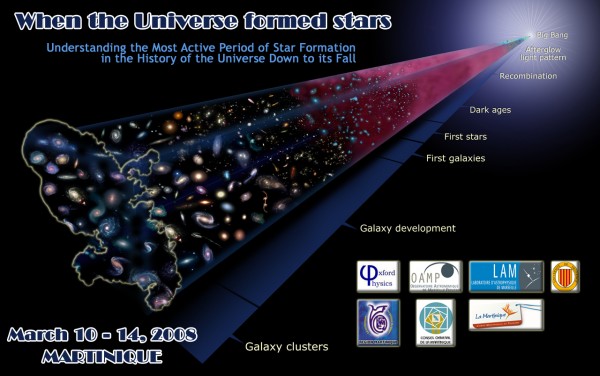
The big question facing me, as far as I was concerned, was deciding whose ideas were right, and which were the ones I should spend my time and energy pursuing?
Make no mistake about it, there are lots of good ideas out there. But having (or exploring) a good idea is not the same as good science. For a good idea to make the leap to being a scientifically good idea, it needs to do both of the following things:
- It needs to explain already observed phenomena at least as well as the presently accepted and used ideas.
- It needs to make new predictions. A new prediction either explains other, hitherto unaccounted-for observations or gives you something unexpected to look for.
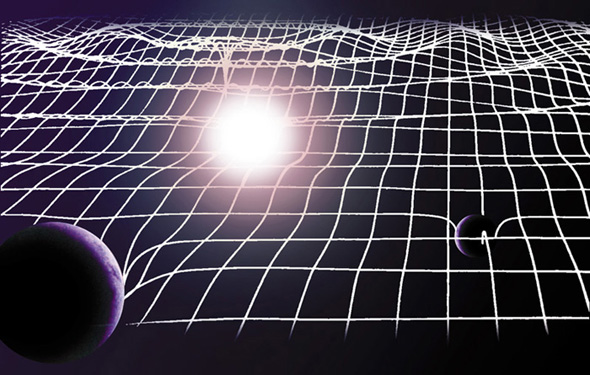
A classic example is Einstein's theory of gravity, general relativity. The big idea was that matter and energy curved spacetime, and that this curved spacetime was the cause of all the effects we attribute to gravitational force.
But it didn't just explain all of the things that the old theory, Newton's gravity, explained. It also predicted an anomaly in Mercury's orbit, which had been observed but was hitherto unexplained. But additionally, it also made a brand new prediction: that near very massive objects, starlight would appear to bend!
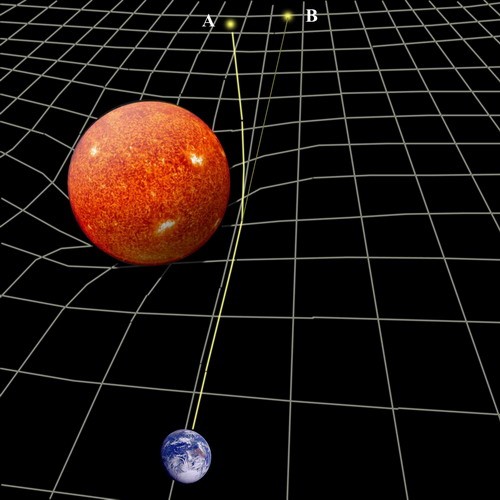
Einstein completed his theory in 1915, and fortuitously, there was a total solar eclipse coming up in 1919, where this new prediction could be tested! You can read some details about this observational test of general relativity, or you can just read the New York Times' headlines reporting the results.
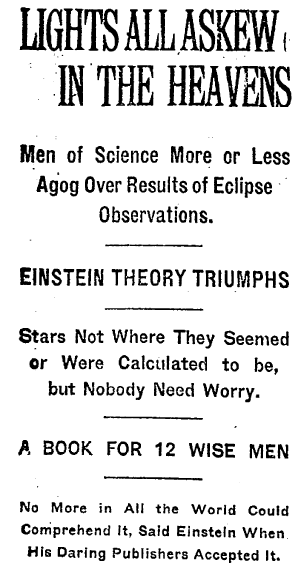
That was an easy one. And although general relativity is now popularly accepted, it took an awfully long time before that was the case. (Some of my older readers may even remember that!)
So I started learning. Looking at the predictions of different theories, looking at their ranges of validity and where they broke down, learning about the different observations and their uncertainties, and concluding what was probable, what was possible, and what was ruled out. And a cohesive picture started to come together. I learned how to measure the distances to different objects, both in and out of our galaxy.
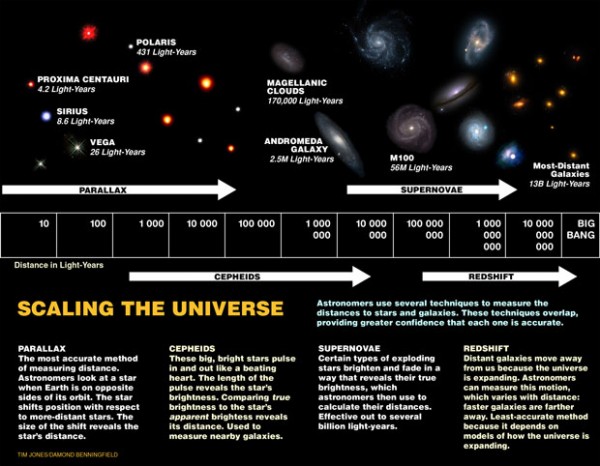
The conclusion drawn from that? The more distant objects were, the faster they were receding away from us. This leads to Hubble expansion, and the picture that the Universe was expanding and cooling, and therefore was hotter in the past. What does that lead to?
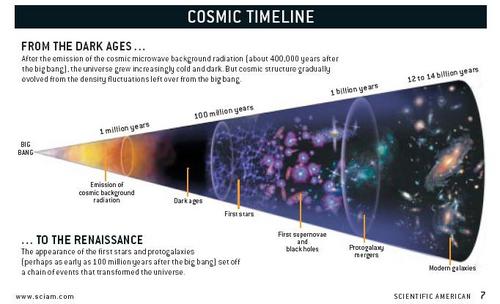
The Big Bang! Although many alternatives are plausible based on Hubble expansion alone, the Big Bang was the theory that made the correct predictions for phenomena like the Cosmic Microwave Background and the abundances of the light elements, while the alternatives fell by the wayside.
But there were still some serious issues with the structures that formed in the Universe. On small scales, we measured how quickly individual galaxies rotated, and found that our predictions of how quickly they should rotate (line A, below) didn't match up with how quickly they actually rotate (line B, below)!
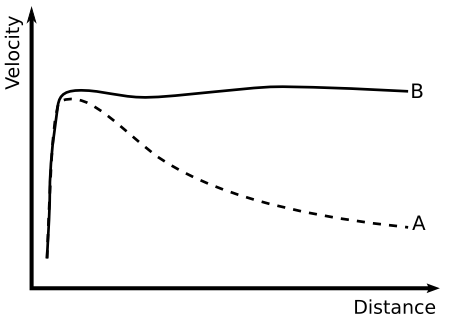
Two ideas quickly emerged to deal with this problem, originally called the "missing mass problem". One was Dark Matter, or the idea that there was more matter in the Universe than just protons, neutrons, and electrons could account for. And the other was to modify gravity, saying that the laws of gravity could be tweaked to account for these observations.
And neither one of these options appeared to be very satisfying to this young astrophysicist. (Which must have been maddening for his advisor!)
So we look for more evidence. These two ideas give different predictions for what happens on larger scales than galaxies. According to dark matter, there's a diffuse, massive halo around every gravitationally bound structure, while according to modified versions of gravity, the laws only become different at very small accelerations.
Both versions provide an explanation for rotating galaxies, and to be completely honest, the modified gravity version is slightly better at that. But how do we decide which one's right?
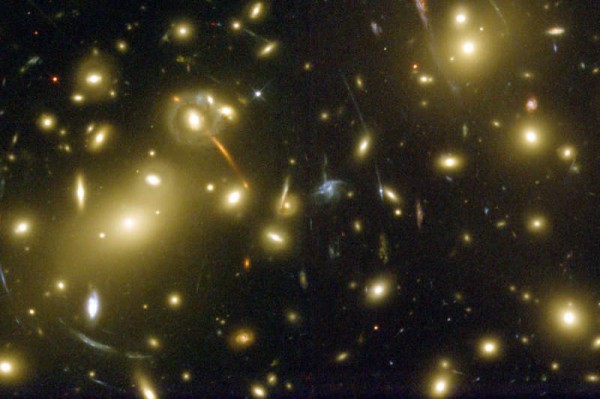
We have to make more predictions and more observations, and see which one works better. First off, we take a look at clusters of galaxies (above). Again, there's a discrepancy between what happens with standard gravity and normal matter and what we observe; the galaxies fly around too quickly for how much normal matter is there.
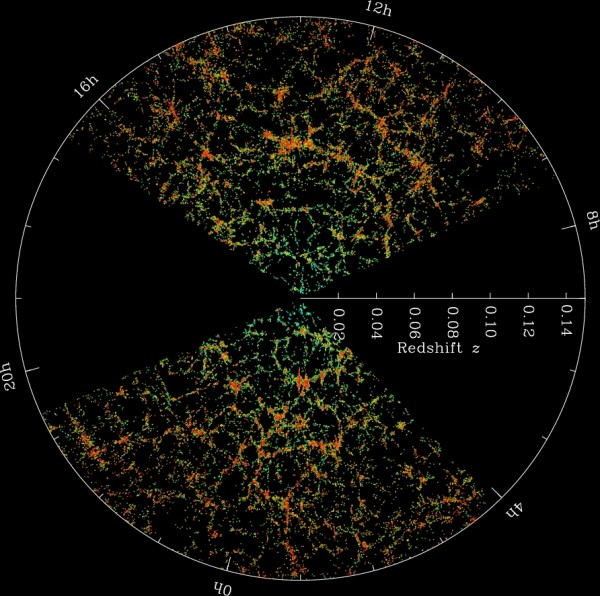
Second, we can look at the large-scale galaxy distribution. How do these galaxies cluster? There seems to be not enough mass to produce the structures that we see, unless we either include dark matter or modify gravity.
What are the results?
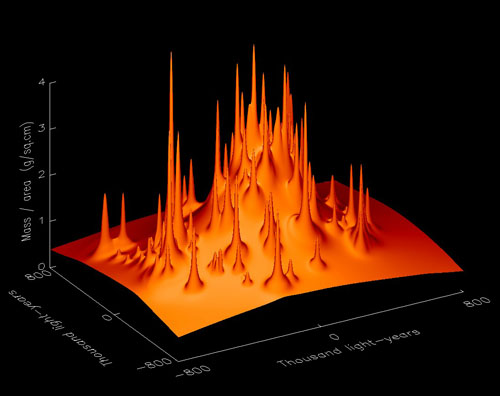
Dark matter works great for both of these, while modified gravity doesn't do a very good job with the clusters and fails abominably at reproducing the large-scale structure of the Universe. (If you want a little more detail, Silk damping is far more important in modified gravity than observations allow.)
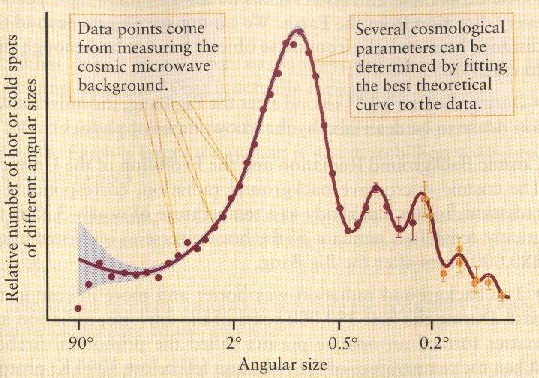
There were also the anisotropies in the cosmic microwave background, which heavily favored dark matter and which modified gravity couldn't explain, which was yet another piece of evidence pointing towards the same conclusion.
So I was in favor of dark matter, but I wasn't entirely convinced. I wanted a "smoking gun" piece of evidence for dark matter. Something that was an entirely new prediction that we could look for -- much like that 1919 eclipse was for general relativity -- and decide whether dark matter predicts what we're going to see.
Well, here's one for you. What would happen if you took two of these clusters of galaxies and smashed them together?
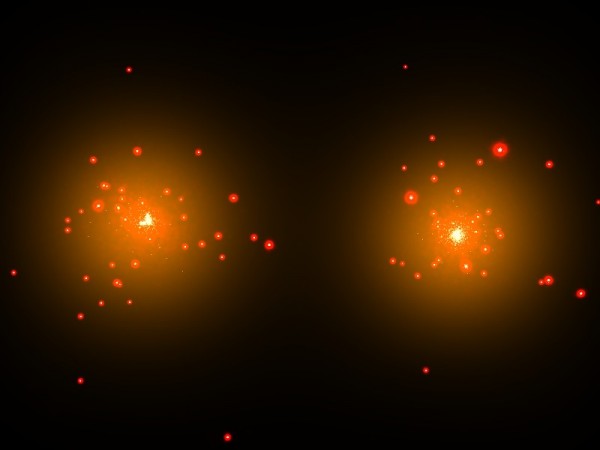
The individual stars and galaxies should be like bullets fired towards one another: very small and very unlikely to hit one another. In other words, the light-emitting parts of the galaxies -- the stars -- should pass right through one another. But most of the normal matter -- the gas and dust -- should collide, smash together, and heat up.
According to a Universe without dark matter, most of the mass should be where these galaxy clusters smash together, while if these clusters did have dark matter halos, those halos, much like the individual stars, should pass through one another undisturbed.
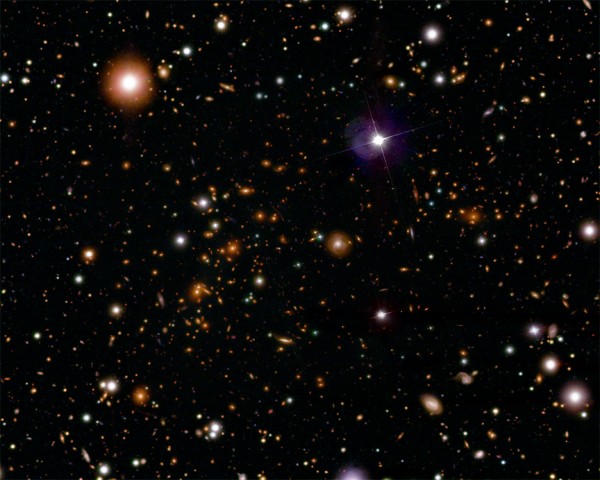
Well, I had the good fortune of being in graduate school at the same place where this guy was working at the time. He was part of a group that examined the cluster above, known as the Bullet Cluster. These are two clusters of galaxies that have just recently collided into one another!
You can look at the gas in them, too, by looking in X-ray light. Where are the X-rays? If these clusters just recently collided, they ought to be in between these two clusters. Let's take a look (in pink), and see what we get.

That's just what we expect. But now we have to ask, where's the gravity coming from? If there's no dark matter, the gravity should line up with the gas. But if there is dark matter, the gravity should line up with the individual stars. Let's take a look at what the mass -- due to observations of gravitational lensing (a verified prediction of general relativity) -- is telling us.
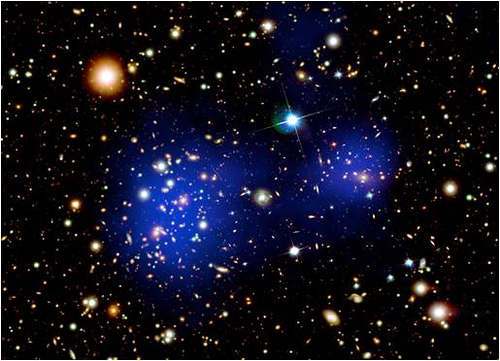
Not entirely convinced? Let's overlay all three images atop one another and see what we get.
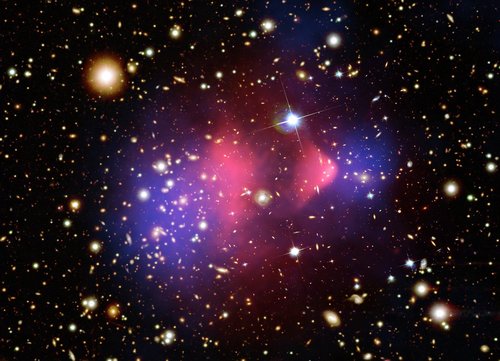
That was the last thing I was waiting for: a new prediction made by dark matter, where the observations gave me exactly what the predictions told me they should.
In other words, before the collision, gravity, stars, and gas all lined up. After the collision, the gas (which is where most of the normal matter is) doesn't line up with the stars. But gravity does. This only works if there's some extra type of matter that doesn't smash together and collide like normal matter (i.e., protons, neutrons, and electrons) does.
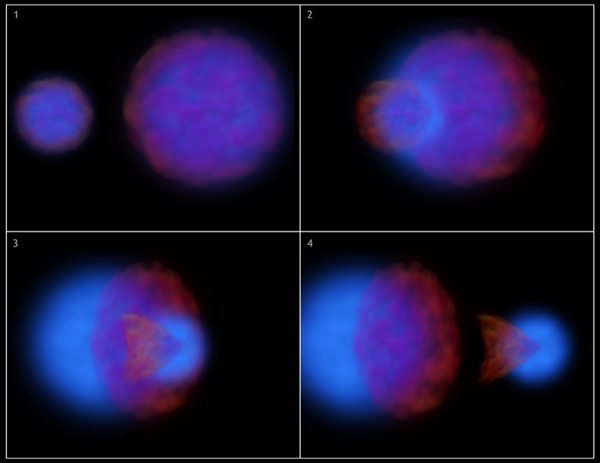
And that's what convinced me that dark matter's a far better explanation than anything else out there for what's going on, gravitationally, in the Universe.

Based on the evidence of galactic cluster collisions, and my lying eyes, DM particles appear to be neither attracted nor repelled by other DM particles. Unlike Baryonic Matter which provides us with a spectacular light show, DM particles donât appear to give a cuss one way or another.
On what scientific basis was it determined that particles of DM needs must attract each other?
From your article of 26 March 2010, in response to an article by Hernandez and Lee on the growth of black holes and the absence of runaway growth in same that would be expected from the existence of attractive DM particles, you stated:
So something is amiss. What gives? Do black holes simply not absorb dark matter? Improbable!
Accepting the outcome of observations as possible, have any simulations ever been done on the basis that perhaps DM and BM mutually repel and, if so, what effect did this have on distance calculations based on the intensity of light from gravitationally lensed distant galaxies?
Would it help to explain the larger than expected apparent dimming, or would we still need to rely on a sudden and inexplicable start of an acceleration in the expansion of the universe commencing four billion years ago?
Targo that is the point of a "dark" matter model, It does not interact via electromagnetic or weak interactions. It DOES interact even with itself via gravity, but the particle model of dark matter has the particles so small that this is a small interaction. This attraction (DM to BM and DM to DM) does cause the model to predict things like the structure of the universe, galaxy orbit speeds and the location of dark matter in the bullet cluster. So no there is no repulsion or the model wouldn't predict the right location of mass and regular matter for the bullet cluster and the large scale universe structure would be different. This would make the "dark matter" model pretty useless.
So we have a model with no interaction with any of the Standard Model forces, but with standard gravity from GR for the detected masses of dark matter. That is the current model. You could do some kind of new MOND to try to shoehorn Dark Energy with Dark Matter, but aside from the "dark" in the name and that they are both astronomical they have nothing much similar about them. The names are unfortunate, dark matter should really be called transparent matter, or something like that.
You don't get runaway growth of Dark Matter for reasons why it's hard to form stars without heavy elements. Yes, lots of dark matter will clump together (hence structure formation), but there is going to be pressure support that keeps it from clumping "all the way". That is, dark matter particles attract each other, but they're all whipping around fast enough that they pass by each other instead of forming pure clumps. If you start with a big, cold blob of dark matter, as the particles all attract each other, they'll all get moving faster -- equivalently, a higher temperature for the dark matter gas. If you want to make them into a condensed blob, you have to have some way of taking the energy out of the system that gives them pressure support.
When stars form nowadays, it turns out that exciting electronics states in heavy elements (say Oxygen), which then radiate away energy as the states decay, is important to getting rid of the energy that allows normal matter to clump and form stars. (There are other processes too, of course.) With dark matter, without something equivalent to send energy away, it's hard to form big clumps.
Assuredly *some* dark matter does get pulled into black holes, and especially the black holes at the cores of galaxies. But the range of significant influence of those things is very very small compared to the equilibrium size of dark matter halos.
Is it possible/likely that the LHC will settle some of these questions/speculations within the next couple of yrs., or will the answers more likely come from other venues?
Good eve and thank you.
A really nice run through of the process. It's another one I will definitely share w/friends and family.
Small question. How old does dark matter have to be? That is, when would it cool out of the mix like regular matter?
Thanks
Can you tell me what are the properties of dark matter.. and the difference between dark matter and dark energy.
As they both are here save basic physics.
@Markk
It does not interact via electromagnetic or weak interactions.
I know that.
It DOES interact even with itself via gravity,
It does not appear to interact with itself in any way judging by its actual behavior in galactic cluster collisions. Not even if you squint your eyes really hard when you look.
It doesnât attract, repel or âannihilateâ with itself. It only appears to respond to baryonic matter: Negatively? Positively? How can one be sure of the direction?
DM appears to respond to Baryonic matter with a vengeance but not to particles of its own type.
â¦but the particle model of dark matter has the particles so small that this is a small interaction.
How big (compared to, say, the size of a hydrogen atom) is a DM particle? Nowhere, as in not anywhere, have I seen any serious speculation as to the actual size of DM.
You could do some kind of new MOND to try to shoehorn Dark Energy with Dark Matterâ¦
I have absolutely zero interest in MOND.
It explains one aspect reasonably well and totally fails in every single other.
It does interact gravitationally, it's just that gravity alone isn't enough to slow down these light, fast-moving particles much. For that, you need friction, which is electromagnetic interaction. I know Ethan has covered this before, so you might want to dig into some of his earlier Dark Matter posts for a better explanation.
@Dunc
It does interact gravitationally
Where did I say otherwise?
Please read what I wrote.
Stars don't smash together in these collisions, and they're made up of perfectly normal matter. Is there any reason to believe that the non-radiating mass is not usual matter in a relatively cold/condensed form? For example, a free-floating neutron star would not be a bright emitter by itself; even in a galactic collision, would enough gas accrete on it to make it bright anywhere near the amount exhibited by the same amount of stellar mass?
Targo, DM responds to gravity from baryonic matter exactly the same as it responds to gravity from DM. Baryonic matter responds to gravity from both types of matter exactly the same way too. The interacting particles must conserve both energy and momentum and with only gravitational interactions the energy can't be radiated away or otherwise dissipated.
What Rob says in #3 is somewhat misleading. "Pressure" is a collective property. DM particles are not behaving "collectively", so "pressure" maybe isn't the best term to use. Each particle of DM is in its own orbit around the center of mass of all the matter in its vicinity. Change the distribution of mass and you change the local gravitational field and you change the trajectory the DM particle moves in, but that is all that can change it.
When a massive object like a star moves through a cloud of DM, the trajectories of all the DM particles it interacts with are changed. Particles on the left get deflected to the right, particles on the right get deflected to the left. On average the trajectory of the star isn't changed much because the DM density is so small. Individual DM particles may have their trajectories changed by 10's of km/s, changed by the orbital velocity of the star at the distance the DM particle was from it when the star passed by. But since DM particles are already moving in random directions, the passing of the star doesn't change the overall velocity and mass distribution of the DM very much.
So in a nutshell, the common connection between DM and BM is gravity? This gets me thinking about the idea of higher dimensions and gravity leaking across many...hmm
As always Ethan gave an excellent explanation of current theory; but he gave little attention to alternatives theories and discounts the problems with current theory.
Regarding the red-shift of distant galaxies, Hubble said that, "red-shifts may be expressed on a scale of velocities as a matter of convenience... The term "apparent velovity" may be used in carefully considered statements, and the adjective always implied where it is omitted in general usage." Einstein agreed. Until an "inflation force" is found I don't see any reason to drop the adjective "apparent". And Hoyle, Burbidge & Narlikar (2000, A different Approach to Cosmology)suggest that "among all of the observational discoveries of the past 30 years, it has been those which involve the measured redshifts which cause the most problems. They are so difficult to understand and so unexpected, that discussion of them has been almost completely left out of other books on cosmology."
Wiki summarizes, "modern cosmology might require an inflationary force, dark energy, and also dark matter composed of fundamental particles outside the scheme of the standard model. The existence of these has not been proven..." Now I have no doubt that there are perplexing observations and that the hypothesized "inflationary force, dark energy, and dark matter" are the best working hypotheses and might prove to be the answers; but let's wait until some fundamental particle or more than "explanation by definition" is found. In the meantime I'd suggest using the adjective "apparent" : "apparent inflationary force", "apparent dark energy", "apparent dark matter". I know this terminology is cumbersome; but it keeps the excellent observations separate from the hypothesized "apparent solutions". For example defining "dark matter" does not make it so. To make it so, we need to know things like mass and spin and half-life.
Next, "Einstein's cosmology involved a space that had the overall shape of a 3-sphere" (Susskind). But as Sandage points out, "In the most popular model... space-time is precisely "flat" in the Euclidean geometrical sense." As far as I understand the only problem with 3-sphere cosmology is that the mathematics is too difficult and big bang theorist think it would make no difference. Thus super computers are being put to other uses. I also think that the adjective and phrase "apparent 3-dimensional Euclidean space" should be called out in the big bang theory (and other theories).
Now this is a short list of definitions being promoted as solutions. Clearly there are observations that suggest for example the "apparent dark energy" as a possible solution. But there are alternative interpretations of at least some of the dark matter observations. For example, Cooperstock (2009 book, General Relativistic Dynamics) asserts, "Einstein's general theory of relativity, could account for the observed flat galactic rotation curves without the requirement for vast stores of mysterious dark matter." In other words, the entire idea that vast quantities of invisible "dark matter" are the dominant form of matter in our visible universe is flawed from its first conception; because it is based upon the incorrect assumption that Newtonian gravity is a sufficient gravitational theory at the galactic level. Cooperstock "wonders how different physics might have evolved had the early astronomers made themselves more knowledgeable about general relativity and made the kinds of calculations for galactic velocities that we have described in this book." Now I don't assume that Cooperstock's explanation deals with all of the "apparent dark matter" observations; but when general relativity explains the observational data; why not remove that observational data from the "apparent dark matter" discussion.
Again and again we hear that the CMB explanation seals the big bang theory. In that regard, I think it is worth reading Hoyle, Burbidge & Narlikar (2000, A different Approach to Cosmology, Chapter 8 The cosmic microwave background-an historical account). "And had Bondi, Gold and Hoyle had the wit to recall McKellar's determination of 2.3K for the thermal excitation of CN, it is likely that the big-bang theory would not have been on-stage at all." They further suggest that, "In other words, the fluctuations.. could have been produced in very many ways... We are in the realm of untestable theory which many would argue is not physics but metaphysics." Elsewhere they summarize, "For some the idea of creation was acceptable if it took place at an early time and only once, i.e. a big bang, but for it to go on steadily at a rate which made it undetectable locally was unacceptable... it is clear that in part at least some of our colleagues were driven by religious motives. In any event the approach taken by nearly all of the professional community of astronomers was to look for evidence which would show the steady-state model was wrong. A series of observational arguments was used, without anybody looking for evidence that might support the model." Further, Hoyle, Burbidge and Narlikar assert that, "It is common to find students emerge from a cosmology course in modern times believing that the big-bang theory "explains" the observed microwave background and that it also "explains" a cosmic helium value with Y close to 0.25. This is to distort the meaning of words." (Chapter 9 The origin of the light elements)I think this book is a most level headed review of current and historical theory up to 2000 by 3 eminent astronomers (2 now dead). Those suggesting that it is sour grapes have not personally read it.
Now if Ethan has a better summary of the alternative theories to the big bang; please share it otherwise I suggest:
A Different Approach to Cosmology, (2000) by Hoyle, Burbidge & Narlikar
General Relativistic Dynamics: Extending Einstein's Legacy Throughout the Universe, (2009), Fred I. Cooperstock
Neither of these books are lightweight. They have stuff that an amateur can understand; but they have the references and the detailed calculations that only a professional can understand. Cooperstock is an emeritus professor of general relativity; I think Hoyle & company needs less introduction.
Some of these authors key conclusions need as much review as Ethan gave to a weak paper in his review post titled Big Bang Alternatives, anyone?
I think that some of the conclusions of these authors are valid and call into question the "apparent solutions" of the big bang theory. We are kind of like the ancients who most clearly observed the wanderings of the planets and concluded that there must be epicycles; and I agree the data of the wandering planets does show "apparent epicycles" which has been disproved as has the "apparent aether" and the "apparent unilimited velocity of matter" and the "apparent action at a distance of Newtonian gravity", etcetera.
If you need more evidence, a history of the evidence for dark matter is summarized here:
http://theeternaluniverse.blogspot.com/2010/06/great-history-of-evidenc…
So, the ideas related to there being a cosmological constant or perhaps more likely a variable yet have a place? The word "conflux" might well be applied to be inclusive of the many various forces at play for any point in the universe, particularly if we believe it all developed out of a single bang, but apparently new matter/energy has the annoying habit of popping up anywhere out of nowhere.
The time thing still gets me though. The farther away we look, the more into the past we witness the earlier universe towards a perceived beginning, and yet towards this beginning what we see appears to be expanding while moving away ever faster and it matters not which direction we look, and it's all in the distant past which is getting ever larger and more distant. Excellent metaphysical material, don't you think? Or at least fodder for a good many more years of research.
It does interact gravitationally, it's just that gravity alone isn't enough to slow down these light, fast-moving particles much.
Targo @9:
In your post @7.
@David Holland
DM does not appear to interact gravitationally with itself in any manner, shape or form.
DM appears to react strongly with BM, in the gravitational sense, in the 'push away', not the 'come to me' sense.
Why else would most DM separate away from the BM of a galaxy to form a large halo?
Couldn't the manner in which galaxies rotate be explained just as well with a DM particle that repels BM?
Actually, if it were the case that DM repels BM that would have enormous implications for power generation and air transport.
Too good to be true, perhaps.
Targo -- your conception of the model is fairly mixed up.
DM *does* interact gravitationally with itself. If it didn't, we wouldn't have galaxy clusters or galxies at all. The growth of structure is driven primarily by the dark matter clumping together because of the gravitational attraction of dark matter partciles to each other.
A galaxy is made up mostly of DM. The DM clumps as much as it can -- making the big galactic dark matter halo. The baryonic matter then falls into the potential well created by that dark matter. Because the baryonic matter interacts in ways other than gravitationally, it's able to lose energy through radiation, and falls further into the potential well than the dark matter particles do.
As such, it's not dark matter "pushing away" from the baryonic matter and making extended halos. Rather, the dark matter makes (relatively) diffuse halos, and the baryonic matter clumps *more* than the dark matter. But they both clump.
I don't know if the question makes sense, but when do we get dark matter (and dark energy)? In all of the discussions on the early universe, inflation to end of opaque, it doesn't seem to matter the least if there's just regular mass, regular +5x dark, or regular +5x dark +20x dark energy. How does the model hold up at that stage?
@Thomas:
Actually, it has been *measured* (using different methods) that space is essentially flat - this is not simply a convenient assumption.
Ethan already looked at Cooperstock's ideas - and found them wanting. See comment 20 here: http://scienceblogs.com/startswithabang/2009/09/dark_matter_part_i_how_…
Pardon? Our models about the fluctuations in the CMBR are not testable?!? What nonsense is that?
In light of the fact that most cosmologists today are atheist (according to Sean Carroll), it seems highly unlikely that the Big Bang model was only accepted because some cosmologists "were driven by religious motives". It was accepted because it fitted the evidence best!
If there is so much evidence which contradicts the model, why *should* anybody look for supporting evidence? They have it backwards - they proposed the model, so its *their* job to provide supporting evidence, and it is the job of other people to try to prove it wrong (and even better, they themselves should first look for evidence against their ideas!). That's how science works!
Nice that they assert that. What about providing some evidence that these claims are right?
Well, simply judging from the quotes you provided, it *is* sour grapes. If you want to claim that it is "level headed", you should explain how they arrive at their conclusions, not simply state the conclusions - because these conclusions look rather ridiculous to other people who know something about cosmology.
I already mentioned that Ned Wright examines the claims of Hoyle et al., and shows them to be wrong. Have you looked at his pages in the meantime?
This article is the closest I have seen, but is there a "Dark Matter for Dummies" that a non-physicist can understand?
DM may or may not exist and I don't know enough to judge.
I do know one thing, however. The rotation curves can be fixed by applying Newton' s law correctly (not sphere approximation) and solving the inverse problem: what is the matter density that gives the observed curve? The density solution is quite realistic. I found published papers making the same observation, but nobody is listening. I am waiting for somebody of authority to rediscover this, and determine what impact it has in the DM predictions.
If the analysis of the rotation curves is indeed wrong, it is possible that the same error is repeated/propagated and magnified in all the other interpretations of various data (clusters, etc).
In this sense, dark matter may just be the manifestation of the correction of the error in applying Newtonian equations.
I am not pro or against DM. The cosmology community is doing a disservice to science by at least
appearing to fudge the path from observation to theory whefre DM is concerned. I tried to follow the
path like a diligent student, but I gave up after encountering the rotation curve dogma. If there is a
good reason for the dogma, the cosmologists have kept it to themselves. Everybody I asked was
"sure" the analysis was done. The only analysis with full Newtonian equations I saw "assumes"
exponential distribution. That does not work, obviously. The solution to the inverse problem is not
exponential. The inverse problem has not been studied carefully to be rejected off hand.
The reason why DM theory is on the table has to do to the fact that Galaxies rotation does not behave as predicted, like on a Solar System
for example, where planets close to the Sun orbit is fast, and planets like Neptune orbits slow around the Sun. In a Galaxy, everything orbits
around the center at the same speed.
So to make sense, Dark Matter was added to the evacuation. It cant be seen, but it can be detected ( Gravitational lensing )
Once I learn that gravitational lensing was used to detect Dark Matter,
I realized there could be another reason for this abnormality.
What if..... the reason Galaxies seem to rotate at the same speed is an illusion caused by Super Massive Black Holes in the center of the Galaxies slowing down
Time ( Time = Measurement of movement ).
It was Einstein's general theory of relativity that was the base to understand black holes. Where gravity affects time.
The more mass an object has, the more it can slow down time.
I think Super Massive Black holes in the center of Galaxies are slowing down time ( movement ) in the center of galaxies,
but the effect does not extend all the way trough the Galaxy , so the center that should be moving fast... moves slow, but the rest of the Galaxy rotates at normal speed, making the illusion
that the Galaxy is rotating at the same speed. This super Gravitational field on the center of each Galaxy should be detected by gravitational lensing.
SOMEONE SAID,
"For some the idea of creation was acceptable if it took place at an early time and only once, i.e. a big bang, but for it to go on steadily at a rate which made it undetectable locally was unacceptable... it is clear that in part at least some of our colleagues were driven by religious motives."
This is so categorically false, in the way you are asserting it, and quite frankly reeks of your own religious motives.
Science was plagued by the steady state model due to the exact opposite of what your claiming. It was the myopic desire to eliminate a beginning that caused the Big Bang to be accepted so late. Logicians had worked through the problem over the centuries, citing the concrete, undeniable impossibility of an infinite regress of events and this fact--which is as ironclad as 2+2=4 was being denied by some of the greatest minds in history because they didnt like where it led.
The facts are clear. Atheists or those with atheistic leanings flocked to the very fields that were tasked to explain origins. Because Theists already believe they have that answer, these disciplines are primarily filled with atheists who can hardly be called unbiased--as them being proved wrong is not exactly like missing the Ice Cream truck--its the biggest mistake one can make-- which obviously is a powerful motivator.
So, as a Christian, I dont reject any of the well tested facts or theories of science today. But with each new parameter(now Dark energy and matter)which seems entirely plausible to me, the evidence that confirms what every normal human being sees in all of 3 seconds it's overwhelming that Intelligence is behind the Creation.
Just the other day a Cosmologist said the Earth WILL be impacted by another extinction level asteroid. He used probabilities as fact and everyone in the field agrees. Just a few days ago they also said the odds of The Star Betelgeuse exploding in 2012, are quite small. Betelgeuse may explode tomorrow night, or it may not go nova until the year 100,000 A.D.--
I agree with them but here's the problem. The odds of this star exploding 2 seconds after you read this are infinitely more probable than even the Atoms cohesion let alone DNA, inflation, the Constant, dark matter--I mean you could go on forever with all the insurmountable improbabilities of our universe. The evidence is clear to everyone but the very people studying the subject--and why?--because they're atheists.
Please understand the probabilities here(that are accepted in science and quoted daily as I showed above)...That Star exploding exactly 2 seconds after I write this are in the realm of odds that should be considered CERTAIN by anyone who accepts the odds of this Universe from randomness. The odds of that Star exploding right this second are as far as the Plank Length is from the Observable Universe---yet the Cosmologist said the odds were quite LOW it would explode this year.
Again, I agree. So why is it that Odds that are effectively Zero being disregarded by the very same people?
How about getting some agnostics in these fields? Why aren't there more? I'll tell you why--because even they are beaten back by these people's bias.
The fact is-- the public does not trust these people anymore because their bias is so obvious. I think evolution is an excellent theory but We have people who wont accept a single fact presented because they know who its coming from. Now faced with the odds-- they propose multiverse--which is such a joke that it makes donkeys popping in and out of existence probable and Hitler naked on a unicycle invading Poland reasonable to avoid where the facts have taken them.
You want the general public to accept science? Throw these bums out or ban them from speaking on origins because they have become the laughing stock.
Agree with Jason. These guys can't see the forest for the trees with their biases.
"these disciplines are primarily filled with atheists who can hardly be called unbiased–...–its the biggest mistake one can make– which obviously is a powerful motivator."
BULL
SHIT
It's nowhere near the motivation for the accolades of proving someone else wrong.
And you can't prove yourself right without actually BEING right.
That's a huge incentive to try to keep quiet until you've got proof. Unlike the godbotherers, where they can just proclaim faith and get pats on the back.
It is also dumb as fuck and rather indicative of projection to claim that people go in there to find out the truth but prefer to find out they're right rather than find out the truth.
BOLLOCKS AGAIN.
"What if….. the reason Galaxies seem to rotate at the same speed is an illusion caused by Super Massive Black Holes in the center of the Galaxies slowing down Time ( Time = Measurement of movement )."
Nice thinking, but it would be incorrect.
The dilation effect depends on the strength of the graviational field and that is no higher if it's a black hole or odrinary matter of the same mass doing it as far as the galaxies' outer regions are concerned.
very fantastic